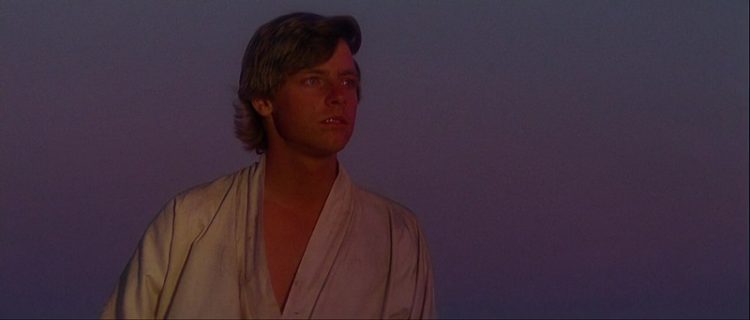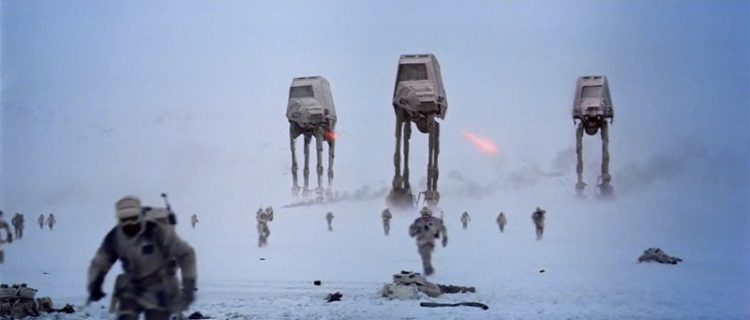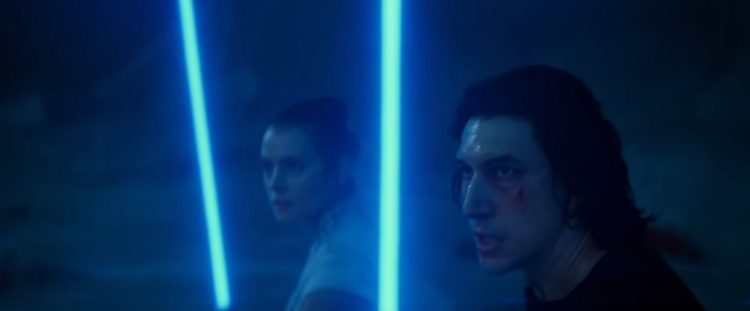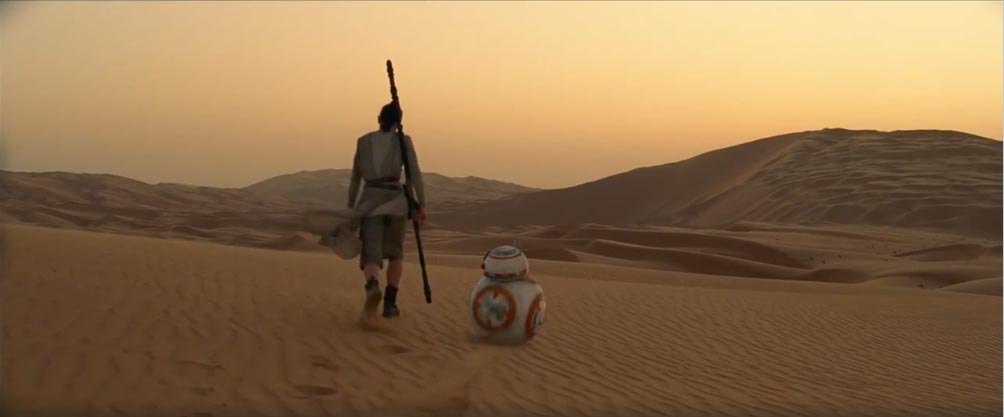With the release of The Rise of Skywalker, the Skywalker saga is (ostensibly) complete. But with nine movies arranged into three trilogies, do each of the three trilogies tell a cohesive story? And do the three trilogies tell a cohesive narrative as a whole?
The answer to both questions is affirmative: each of the three trilogies tells its own cohesive story, and all three trilogies together do indeed form a single cohesive narrative. Get your clichés about “rhyming” out now, because an in-depth analysis of the structure of all three movies is imminent.
Thesis
The sequel trilogy begins with The Force Awakens, in which the villains have created a massive superweapon; fortunately, the heroes are able to completely destroy the weapon in a climactic battle. In essence, this movie serves as a thesis for the ST: “You can become a hero, and defeat an evil far greater than yourself.”

The plot of The Force Awakens directly echoes A New Hope, the first movie in the original trilogy. In A New Hope, the archetypal hero’s journey was used as a sort of equation into which the space operatics were inserted as variables. The Force Awakens does the same thing – only this time, instead of plugging new variables into the more general “hero’s journey” equation, a more specific “New Hope” equation is used, thus establishing the OT as a touchstone in the same way that the OT used mythology.
The first movie in the prequel trilogy, The Phantom Menace, plays with the same basic narrative, but with a subversive twist. At the end of the movie, young Anakin has defeated the battle droids by destroying the Trade Federation command ship used to remotely orchestrate their attack on Naboo.
However, the celebratory final scene in Theed subverts the idea that the hero can defeat the great evil, given that Anakin stands right beside Palpatine on the palace steps as the triumphant “Symponik Nabooalla” blares. While the direct connection between Palpatine and the hooded Darth Sidious is not explicitly established by The Phantom Menace, audience members who have already watched the OT would be hard-pressed to ignore the fact that the victory parade is being overseen by the biggest bad in the Star Wars galaxy. While Palpatine might adopt an alias to conceal his identity from other characters in the movie, the name “Palpatine” was known to be the Emperor’s identity as far back as the original Star Wars novelization, released twenty-three years before The Phantom Menace.
In essence, this makes the PT the odd one out of the three trilogies: while both the ST and the OT have stories that affirm the heroism of their respective protagonists, the PT seems to go through the motions of the same – but the idea is subverted thanks to the presence (and approval) of the saga’s greatest villain at the supposedly triumphant conclusion.

Antithesis
If the first movie in the trilogy serves as the thesis, the second is the antithesis.
The ST wastes no time in establishing this with The Last Jedi. The opening sequence, which picks up immediately after the conclusion of The Force Awakens, places Poe in a familiar situation: a lone starfighter squaring off against a seemingly insurmountable opponent (in this case, a First Order Dreadnought). The setup echoes both A New Hope and The Force Awakens, when a single X-wing pilot was able to pull a David and steal victory from a seemingly undefeatable superweapon.
However, while Poe is able to defeat the Dreadnought, the loss sustained by the Resistance is staggering, and the battle is not considered a victory by General Organa, nor by the narrative itself. If the thesis of the first movie is “a single soldier can overcome an evil plot and become a hero”, from its first scene, The Last Jedi suggests that the practicality of heroism might be somewhat more complicated.
Almost every subplot in The Last Jedi embodies this same theme: Rose, Finn, and BB-8 spend the majority of the movie pursuing what amounts to a red herring, and Rey’s assumption that the legendary hero Luke Skywalker will solve their problems is immediately repudiated when Luke takes the symbol of his heroism – the hero’s saber – and carelessly tosses it over his shoulder.
Consideration of The Empire Strikes Back reveals that it serves a similar thematic function for the OT: after victory in A New Hope, the Rebels face the Empire’s retaliation. Luke follows Obi-Wan’s advice and seeks Yoda, but finds the Muppet unhelpful; meanwhile his friends seek assistance from Lando, but the Empire has compromised him.
When Vader reveals he is Luke’s father, it calls into question Luke’s faith in Obi-Wan. Obi-Wan had been assumed to be a font of truth after his guidance proved invaluable in leading Luke to victory over the Death Star in A New Hope. But if Vader is Luke’s father, it means Obi-Wan lied to Luke when he told him that Vader killed Luke’s father.
Attack of the Clones doesn’t seem to repudiate The Phantom Menace in the same manner. While the ending of Episode I had Anakin standing alongside Palpatine in Theed, Episode II doesn’t push back against Palpatine’s control of Anakin; instead, it doubles down on it. Anakin takes steps toward the dark side when he massacres the entire Tusken Raider village in retaliation for his mother’s death, and Palpatine’s machinations continue to unfold on a galactic scale: the Clone army on Kamino is “discovered” by Obi-Wan and the Jedi send the Clones in against the Separatist droid forces, beginning the Clone Wars.
But when Obi-Wan tells Mace Windu and Yoda that Dooku revealed Palpatine controls the senate, Yoda largely dismisses the (accurate) claim. No one, with the exception of Bail Organa, seems aware of the fact that everything has worked out precisely as Palpatine had hoped.
While Empire Strikes Back and The Last Jedi may serve as the antithesis of the first movie in their respective trilogies, Attack of the Clones feels more like an affirmation of the thesis of The Phantom Menace: although our heroes may have the best of intentions, they are being manipulated by the translucent hand of Palpatine.

Synthesis
The Rise of Skywalker gives both the heroes and the villains the opportunity to shine. Rey gets the chance to fulfill her hero’s journey, overcoming the doubt instilled in her by the events of The Last Jedi. While she struggles with her path, at one point doubting her ability to fulfill the role of hero (symbolized by her refusal to take the hero lightsaber, saying she hasn’t earned it), she ultimately succeeds, even if it isn’t precisely the way the audience expects (rather than wielding Anakin’s lightsaber against Palpatine, she wields Leia’s). At the conclusion, we see that Rey has crafted her own lightsaber, thereby completing her unique personal journey as a Jedi.
After having destroyed it in The Last Jedi, Kylo Ren rebuilds his signature helm, affirming his commitment to the dark side, pushing back against opposing factions and consolidating his power. Later, he rejects the name Kylo Ren and hurls his lightsaber into the seas of Kef Bir. His journey is completed when he arrives on Exegol and wields the hero lightsaber – built by his grandfather during the Clone Wars – against Palpatine.
In Return of the Jedi, Luke gets the chance to confront Obi-Wan’s Force ghost. This is another instance of a synthesis between A New Hope and Empire: is the story Obi-Wan told in IV accurate, or is the revelation delivered by Vader in V the truth? Return of the Jedi wants it both ways: Obi-Wan explains that the statement about Vader killing Anakin was true, “from a certain point of view”, synthesizing the two seemingly incompatible pieces of information.
Return of the Jedi also plays with the idea that Luke may have been tempted into turning to the dark side when Luke arrives at Jabba’s Palace and Force-chokes the Gammorean guards. This “temptation” of Luke toward the dark side is one of the primary conflicts that drives the movie, and Luke’s struggle between the two halves can be viewed as an attempt to reconcile the heroics of A New Hope with the doubt and fear instilled by his failures in Empire. The familial connection between Luke and Vader does inform the climax, but rather than Luke being pulled over to the dark side, Anakin is pulled back into the light, and ultimately sacrifices himself in the process of killing Palpatine.
Revenge of the Sith, however, follows the pattern set by Attack of the Clones, and essentially triples down on the throughline that has informed the PT: the noose that Palpatine has been weaving around Anakin’s neck for two movies finally tightens, and Anakin turns to the dark side, becoming Darth Vader.
There is some degree of synthesis, however, primarily through Luke and Leia. While Anakin was considered to be the key to overcoming the dark side by the Jedi Order, as an audience, we know that Luke and Leia will ultimately fulfill that promise. For this reason, the conclusion of Revenge of the Sith – in which Leia is brought to Alderaan, and Luke is brought to Tatooine – maintains a measure of hope in spite of the overall bleak outcome of Anakin’s journey.

Trilogy of Trilogies
While the pattern of the PT does not necessarily match the rhythm of the OT and ST, when considered as a single, nine-movie narrative, the reason for the subversion begins to come clear. The PT and the OT represent the “thesis” and “antithesis”, respectively, of the saga overall: in the story of the OT, Luke becomes a hero, while in the story of the PT, Anakin becomes a villain (whether the PT or the OT is viewed as “first”, chronologically, is irrelevant: the relationship between the “thesis” and the “antithesis” is not causal; all that matters is that one represents the inversion of the other).
The ST, then, serves as the synthesis, with Ben carrying on the legacy of Anakin and Rey carrying on the legacy of Luke and Leia (who is revealed in Rise of Skywalker to have followed her own path to becoming a Jedi).
From the moment we meet Ben, he is attempting to carry on his grandfather’s legacy – however, he misunderstands the truth of Anakin’s character. This is largely thanks to Palpatine, who has been “every voice [Ben] has ever heard inside [his] head”, a line from Rise of Skywalker that is not coincidentally delivered partly in the voice of James Earl Jones, the voice adopted by Vader when he “kills” Anakin.
However, the truth of Anakin’s character is this: he would do anything to save the people he loves (whether that means Padmé, Obi-Wan, Ahsoka, R2-D2, or Luke). In the PT, this impulse is manipulated by Palpatine to turn Anakin to the dark side. Yet in the OT, Luke is able to “resurrect” Anakin thanks to the same impulse: the compassion Anakin feels for his son leads him to stand against the Emperor, even though he does so at the cost of his physical life.
In the ST, Ben fulfills the preservation of his grandfather’s legacy when he demonstrates that, like Anakin, he is willing to do anything in order to save those he cares about. This demonstrates how Ben’s arc in the ST synthesizes elements of Anakin’s arcs from both the PT and the OT into a single arc: while Ben is manipulated by Palpatine into drawing power from the dark side, just as Anakin was, Ben ultimately turns his back on the Sith in order to ensure the safety of someone he cares about, standing alongside Rey in the final battle.
Likewise, the ST shows Rey following in the footsteps of Luke’s “ideal” legacy: while she is tempted to follow Luke’s missteps and exile herself to Ahch-To, she is able to learn from his mistakes and instead stands against Palpatine, fulfilling her destiny as a hero. Not only does Rey’s ST arc synthesize elements of Luke’s arc from both the OT and the ST, it does so too with Leia’s (symbolically represented during the climax by Rey wielding Leia’s lightsaber against Palpatine, and then, when she defeats Palpatine, both Leia’s lightsaber and Anakin/Luke’s lightsaber).
Do all three trilogies tell a cohesive nine-movie story? That decision will depend on the viewer, but I’d argue it’s as cohesive as possible for a story that spans three generations and took 42 years and countless storytellers to complete – and it turns out that’s pretty darn cohesive.


I think the Hegelian dialectic is really valuable in comparing and contrasting the PT/OT/ST, so I’m thankful to see you use it here. Following your structure, you could say that the OT and ST follow a similar “victory, defeat, ultimate victory” structure, which the PT sort of rejects, sort of adapts.
Superficially, from a good guys’ POV, the PT is “victory, victory, defeat”. For the villains, it is more “defeat, victory, victory”. From a canonical POV, the heroes actually go through a “defeat, defeat, defeat” structure – they lose in TPM by playing into Palpatine’s hands, they lose in AotC by encouraging the use of the clone army and joining a war, and they lose in ROTS for obvious reasons. With this in mind, it’s easier (for me) to not look at the 1, 2, and 3 films as thesis, antithesis, and synthesis, but each trilogy embodying a single aspect (which you do toward the end).
I wonder how much fruit would be borne by using the dialectic to compare certain aspects of the films. Take, for example, the Jedi: the OT shows the Jedi as powerful heroes who should be emulated, even in their flaws (thesis); the PT Jedi are flawed to the core and destroyed (antithesis); the ST Jedi grapple with both the good and bad parts of the legacy of the Jedi, embracing the Order but working to cull the negative aspects from it.
Or the governing body from each trilogy, or the armies from each trilogy, etc. etc.
Thanks for writing this – lots to work with here!
To be fair, it is important to remember that the Jedi “Masters” we see in the OT by the time in Episode 6 are wrong…The Thesis to the Jedi being flawed starts to become apartment around the time of Empire and even in Return of the Jedi when Yoda and Obi-Wan just want Luke to kill Vader but Luke decides to take a different path.
Star Wars is defiantly a series I think that one has to look more in terms of the big picture than the execution or the small minute decisions of the plot and details.
if one sees it like that, then I think Star Wars definitely has a very cohesive overacting narrative.
Very good article!